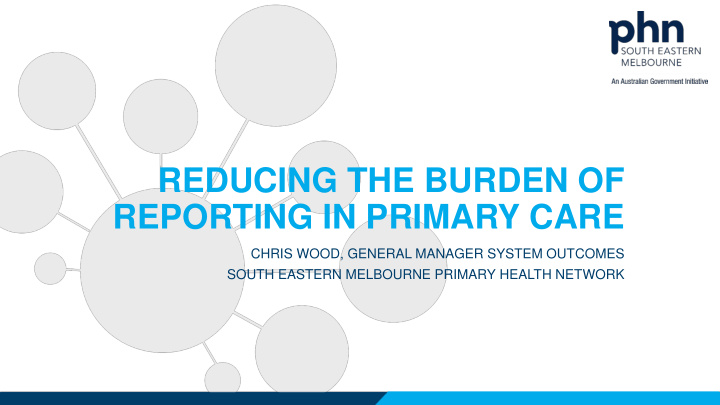



REDUCING THE BURDEN OF REPORTING IN PRIMARY CARE CHRIS WOOD, GENERAL MANAGER SYSTEM OUTCOMES SOUTH EASTERN MELBOURNE PRIMARY HEALTH NETWORK
The problem • Commonwealth Government introduced an extensive minimum data set for all PHN funded mental health services across the country • Service providers • Rarely experienced with data collection and their IT and data management skills are very low • Usually do not have systems in place to support this particular data collection • Do not always see the value of collecting these data – have never had any feedback • The PHN • PHNs are required to provide these data to the Commonwealth • PHNs have limited resources ($ and people) • Data collection is new and staff have limited experience in data collection approaches
The MDS • A relational data model with six tables • Provider Organisation (the organisation) • Practitioner (the individual providing the service) • Client (mostly demographic) • Episode (about the whole period of care for the client) • Service Contact (the individual session) • Outcomes Collection Occasion (the client’s clinical outcomes using one of three tools) • Most tables are collected once, but the service contact with 17 data items to be collected every time a clinician has a clinical interaction with a client • All linked by the organization path
The challenge • To develop an approach to the capture, transfer, storage, management, analysis, and reporting of mental health data • That: • Clinicians can understand and input valid and correct information • That meets the PHN’s reporting requirements • That can be used to provide • Options: • Buy an off the shelf product • Engage someone to do it for us • Do it ourselves • Constraints: • Very short development time • Very limited funding and capacity • Unknown and changing rules (data elements, business rules, definitions)
The approach • Needed not only the most technically sound solution, but also one that would be used and provide high quality business information • Executive wanted • Value for money • High quality and timely reporting • Flexibility and optionality • Happy, engaged, capable staff • Principles • Let clinicians get on with their job – data collection is our problem, not theirs • KiSS • Open source (where possible) • More cost effective • More flexible and customisable • BUT greater learning curve (requires time and talent)
The solution • Rather than talk about it, we thought we’d show it to you...
The Solution
The outcome • Developed new skills – SQL, Python (incl Flask, Jupyter, pandas), d3, git • Can change things easily to respond to new requirements • Can automate the boring stuff • Automatically check monthly data submissions for each provider contract (used to take the provider, contract manager, data team and finance team significant time) • More accurate, errors picked up more quickly, data is more meaningful • Providers received reports for the first time and started to see the benefit of the data • The PHN could monitor and manage provider performance and make informed business decisions • Department received higher quality data
Recommend
More recommend